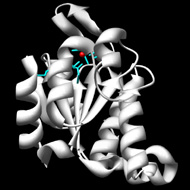Top Level Name
⌊ Superfamily (core) Haloacid Dehalogenase
⌊ Subgroup C1.6: Phosphoserine Phosphatase Like
⌊ C1.6.2: Deoxy-d-mannose-octulosonate 8-phosphate Phosphatase Like
Family known  |
|||||||
| Total |
100%  |
<100%  |
Family unknown  |
||||
| Functional domains | 1396 | 0 | 165 | 1231 | |||
| UniProtKB | 7763 | 0 | 848 | 6915 | |||
| GI | 15331 | 0 | 1587 | 13744 | |||
| Structures | 30 | ||||||
| Reactions | 0 | ||||||
| Functional domains of this subgroup were last updated on Nov. 22, 2017 | |||||||
| New functional domains were last added to this subgroup on Aug. 1, 2014 | |||||||
Structurally characterized enzymes in this subgroup have the C0 (only small inserts seen at either of the two points of cap insertion) cap type.
Parsons, J.F., et al.
From structure to function: YrbI from Haemophilus influenzae (HI1679) is a phosphatase
▸ Abstract
Proteins 2002;46(4):393-404 | PubMed ID: 11835514
No notes.
Static File Downloads
| File Name | Description | Parameters | Stats |
|---|---|---|---|
| network.sg1138.bs60.mek250K.xgmml | One node per sequence network | min bit score = 60 max edge count = 250K |
size = 129M num_edges = 250000 num_nodes = 1396 |
| sfld_alignment_sg1138.msa | Annotated Sequence Alignment, Stockholm format | 170 sequences size: 45K |
| Subgroup ▸ Legend | T  |
K  |
C  |
U  |
S  |
||
|---|---|---|---|---|---|---|---|
| ┗ 1: C1.6.2: Deoxy-d-mannose-octulosonate 8-phosphate Phosphatase Like | 1396 | 165 | 0 | 1231 | 30 | ||
| ┗ deoxy-d-mannose-octulosonate 8-phosphate phosphatase | 165 | 165 | 0 | 13 |



